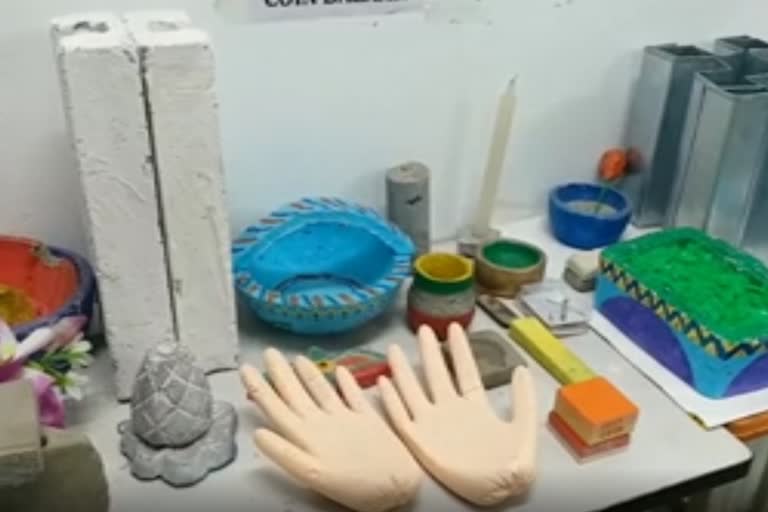নিউজ ডেস্ক,16 জানুৱাৰীঃ তামিলনাডুৰ চালেমৰ এখন ব্যক্তিগত মহাবিদ্যালয়ে বৰ্জিত একক ব্যৱহৃত প্লাষ্টিক পৰিশোধন কৰি তাৰ পৰা সুন্দৰ গৃহ সজ্জাৰ সামগ্ৰী আৰু পুনঃব্যৱহাৰযোগ্য সামগ্ৰী প্ৰস্তুত কৰে ৷ বিশেষকৈ চৰকাৰে একক ব্যৱহৃত প্লাষ্টিক বৰ্জনৰ বাবে লোৱা সিদ্ধান্তৰ পাচতে এই নতুন পদক্ষেপে প্লাষ্টিকৰ ব্যৱহাৰ নিয়ন্ত্ৰণ কৰাৰ বাবে লক্ষ্য নিৰ্ধাৰণ কৰিছে ৷
তামিলনাডুত প্লাষ্টিক ৰোধৰ বিশেষ পদক্ষেপ প্লাষ্টিকৰ বটল আৰু পেলনীয়া ভগা-ছিগা প্লাষ্টিকৰ সামগ্ৰীবোৰ শোধন কৰি কিছুমান টুকুৰা বনোৱা হয় আৰু কিছুমান শোধিত প্লাষ্টিক নিৰ্মাণ সামগ্ৰীৰ সৈতে মিশ্ৰণ কৰা হয় যেনে,ইটাৰ সৈতে ৷ একেদৰে প্লাষ্টিকৰ মোনাসমূহ জ্বলাই বিটুমিন,ফ্লাই এছ আৰু অনান্য উপাদানৰ সৈতে সংমিশ্ৰণ কৰা হয় ৷ যেনে দৰে ইটা আৰু আন নিৰ্মাণ সামগ্ৰীৰ সৈতে মিশ্ৰণ কৰা হয় ৷
কম ওজনৰ প্লাষ্টিকৰ পৰা নিৰ্মাণ কৰা ইটা সমূহ অট্টালিকা নিৰ্মাণত ব্যৱহাৰ কৰা হয় ৷ এই ইটাবোৰে বতৰৰ প্ৰতিৰোধক হিচাপে কাম কৰে ৷ এনে ধৰণে সফলভাৱে প্লাষ্টিকৰ জাৱৰ সংশোধন কাৰ্যই প্লাষ্টিক মুক্ত ভাৰত নিৰ্মাণত যথেষ্ট সহায় কৰিছে ৷
লগতে পঢ়কঃকেতিয়া মুক্তি পাব 'কিক'ৰ চিকুৱেল কিক-2?
Intro:Body:
Salem: A private college in Tamil Nadu's Salem recycles and dismantles once-discarded plastic materials into beautiful decorations and construction materials.
The state government which banned the single-use plastics are now finding it difficult to manage the growing waste generation even after the ban.
To improve the plastic management practices, this college in Surumangalam region has started to re-engineer the waste plastic into raw materials to be used in construction material.
Plastic wastes such as bottles, containers and other utensils once broken are crushed into pellets are mixed with construction materials like concrete and bricks. Similarly, plastic bags are burned and bitumen, fly ash and other by-products are mixed while making bricks providing a solid core of building materials.
If the plastics are lightweight and the bricks made out of them are used in making buildings, it acts as weather resistance and provides low budget options in house construction projects.
Such better ways to successfully manage the plastic waste will go a long way in supporting a campaign for a plastic-free India.
=============================
VO: A private college in Tamil Nadu's Salem recycles and dismantles once-discarded plastic materials into beautiful decorations and construction materials.
GFX: Private college in TN recycles plastic
VO: The renewed push is aimed at controlling the menace of single-use plastic especially after the government came up with an initiative to ban single-use plastic materials.
GFX: Aim to reduce the use of Single-use plastic
VO: Once such materials including plastic bottles are broken or thrown away they are crushed and made into pellets.
GFX: Plastics are crushed into pellets
VO: Such finely crushed plastic is mixed with construction materials like concrete and bricks.
GFX: Pellets are then mixed with construction materials
VO: Similarly, plastic bags are burned and bitumen, fly ash and other by-products are mixed while making bricks providing a solid core of building materials.
GFX: Plastics bags are burned and by products are reused
VO: If the plastics are light weight and the bricks made out of them are used in making buildings, it acts as weather resistance.
GFX: Buildings remain weather resistant
VO: Such better ways to successfully manage the plastic waste will go a long way in supporting a campaign for a plastic free India.
An ETV Bharat report
==============================
BYTE SCRIPT
1.13 sec
Byte: As we are striving for a plastic-free India, we should focus on recycling and avoid single-use plastic
Byte: Plastic is a good material as we can use them as an alternate for other materials.
Byte: The main issue is how we recycle or process them after it breaks
Byte: We have come up with a project to use plastic waste in concrete, where sand is replaced with plastic pellets
Byte: Plastic bags are burnt and bitumen, fly ash and other by-products are mixed while making bricks.
Byte: These bricks can be used in construction and bonds well with other materials
2.50 sec
Name: Dr. R Malathi
Designation: Professor, Civil dept.
Conclusion:



